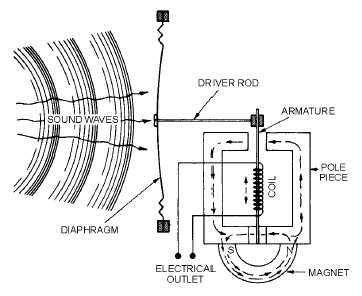1-41
Figure 1-36.—Magnetic microphone action.
When the armature is in its resting position (midway between the two poles), the magnetic flux is
established across the air gap. However, no resultant flux is established in the armature. When a
compression wave strikes the diaphragm, the armature is deflected to the right. Most of the flux continues
to move in the direction of the arrows. However, some flux now flows from the north pole of the magnet
across the reduced gap at the upper right, down through the armature, and around to the south pole of the
magnet.
When a rarefaction wave occurs at the diaphragm, the armature is deflected to the left. Some flux is
now directed from the north pole of the magnet, up through the armature, through the reduced gap at the
upper left, and back to the south pole.
The vibrations of the diaphragm cause an alternating flux in the armature which induces an
alternating voltage in the coil. This voltage has the same waveform as that of the sound waves striking the
diaphragm.
The magnetic microphone is very similar to the dynamic microphone in terms of impedance,
sensitivity, and frequency response. However, it is more resistant to vibration, shock, and rough handling
than other types of microphones.
Changing sound waves into electrical impulses is the first step in voice communications. It is
common to all the transmission media you will study in the remainder of this chapter. We will discuss the
various types of modulation that arc used to transfer this information to a transmission medium in the
following sections.
Q-26. What is a microphone?
Q-27. What special electromechanical effect is the basis for carbon microphone operation?
Q-28. What is a major disadvantage of a carbon microphone?
Q-29. What property of a crystalline material is used in a crystal microphone?
Q-30. What is the difference between a dynamic microphone and a magnetic microphone?

